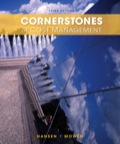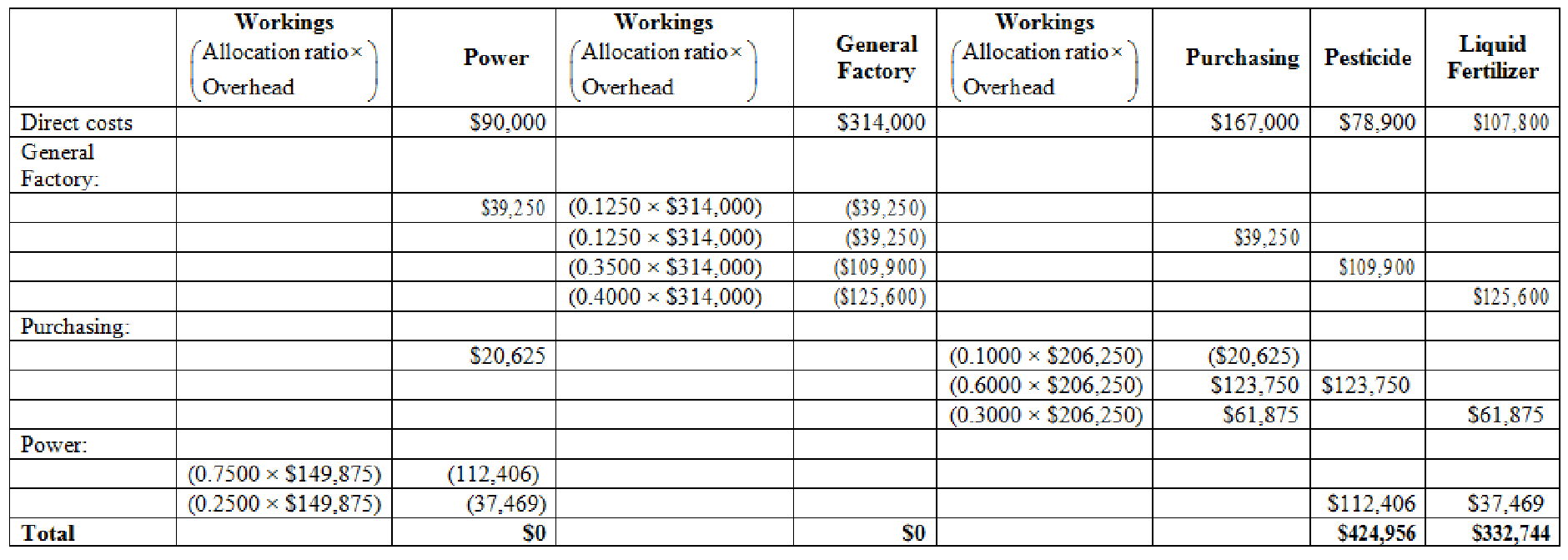
Concept explainers
Refer to the data in Exercise 7.20. The company has decided to use the sequential method of allocation instead of the direct method. The support departments are ranked in order of highest cost to lowest cost.
Required:
- 1. Allocate the
overhead costs to the producing departments using the sequential method. (Take allocation ratios out to four significant digits. Round allocated costs to the nearest dollar.) - 2. Using machine hours, compute departmental overhead rates. (Round the overhead rates to the nearest cent.)
1.
Allocate the overhead costs to the producing departments suing the sequential method.
Explanation of Solution
Sequential method of allocation: The sequential method of allocation foresees that the interactions between the supports departments occur; conversely the sequential method considers only partial account of this interaction.
Calculation allocation ratio:
| Power |
General Factory | Purchasing | Pesticide |
Liquid Fertilizer | |
| Square feet | (1)0.125 | (2)0.125 | (3)0.35 | (4)0.4 | |
| Machine hours | (5)0.75 | (6)0.25 | |||
| Purchase orders | (7)0.1 | (8)0.6 | (9)0.3 |
Table (1)
Calculate assignment of costs:

Figure (1)
Working notes:
(1)Calculate the allocation of square feet to Power department:
(2)Calculate the allocation of square feet to Purchasing department:
(3)Calculate the allocation of square feet to Pesticide department:
(4)Calculate the allocation of square feet to Liquid fertilizer department:
(5)Calculate the allocation of machine hours to Pesticide department:
(6)Calculate the allocation of machine hours to Liquid Fertilizer department:
(7)Calculate the allocation of purchase orders to power department:
(8)Calculate the allocation of purchase orders to pesticide department:
(9)Calculate the allocation of purchase orders to liquid fertilizer department:
2.
Calculate departmental overhead rates using machine hours.
Explanation of Solution
Departmental overhead rates: Departmental overhead rate is calculated by adding the allocated service costs to the overhead costs that are directly noticeable to the producing departments and dividing this total by some measure of activity, such as direct labor hours or machine hours.
Calculate the departmental overhead rate for pesticide department:
Therefore, the departmental overhead rate for pesticide department is $17.71 per machine hour.
Calculate the departmental overhead rate for Liquid fertilizer department:
Therefore, the departmental overhead rate for liquid fertilizer department is $41.59 per machine hour.
Want to see more full solutions like this?
Chapter 7 Solutions
EBK CORNERSTONES OF COST MANAGEMENT
- Calculate the contribution margin per unitarrow_forwardF. Acc prblmarrow_forwardQuestion : Rainbowbird Mfg. has received a special one-time order for 15,000 bird feeders at $3 per unit. Rainbowbird currently produces and sells 75,000 units at $7.00 each. This level represents 80% of its capacity. Production costs for these units are $3.50 per unit, which includes a $2.25 variable cost and $1.25 fixed cost. If Rainbowbird accepts this additional business, the effect on net income will be?arrow_forward
- During its first year of operations, Peter's Plumbing Supply Co. had sales of $370,000, wrote off $5,900 of accounts as uncollectible using the direct write-off method, and reported net income of $40,700. Determine what the net income would have been if the allowance method had been used, and the company estimated that 1.75% of sales would be uncollectible. ??arrow_forwardWhat is the answer?arrow_forwarddo not use ai solution given answer of this General accounting questionarrow_forward
 Cornerstones of Cost Management (Cornerstones Ser...AccountingISBN:9781305970663Author:Don R. Hansen, Maryanne M. MowenPublisher:Cengage Learning
Cornerstones of Cost Management (Cornerstones Ser...AccountingISBN:9781305970663Author:Don R. Hansen, Maryanne M. MowenPublisher:Cengage Learning Principles of Cost AccountingAccountingISBN:9781305087408Author:Edward J. Vanderbeck, Maria R. MitchellPublisher:Cengage LearningPrinciples of Accounting Volume 2AccountingISBN:9781947172609Author:OpenStaxPublisher:OpenStax College
Principles of Cost AccountingAccountingISBN:9781305087408Author:Edward J. Vanderbeck, Maria R. MitchellPublisher:Cengage LearningPrinciples of Accounting Volume 2AccountingISBN:9781947172609Author:OpenStaxPublisher:OpenStax College


